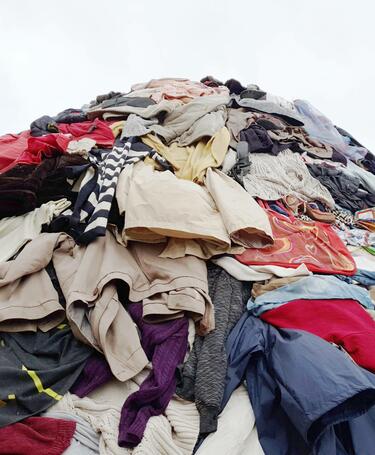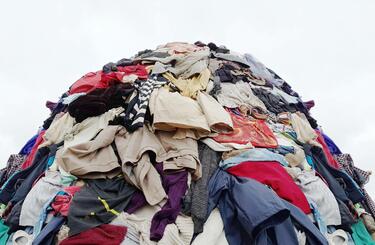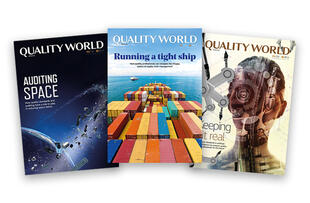
Why 'fast' must go out of fashion
Progress indicator

The fast fashion industry raises a number of questions around quality control, supply chains and sustainability. Dr Pauline Bremner, an associate professor and lecturer in retail and fashion management at Robert Gordon University near Aberdeen, discusses how a greater emphasis on quality is at the heart of mitigating its impacts.
When it comes to sustainability, there is little doubt that the fast fashion industry has plenty of questions to answer.
‘Fast fashion’ is the term coined for the mass production of cheap, low-quality clothing, quickly designed, produced and distributed, which follows the latest trends and is often disposed of after being worn only a couple of times. According to statistics from uniformmarket.com, fast fashion has developed into a $150.82bn industry that continues to grow, soaring from $91.23bn five years ago. However, on the flip side of such figures, the UN Environment Programme names the fast fashion industry as the second-biggest consumer of water, responsible for about 10% of global carbon emissions.
While such statistics make for stark and worrying reading, the question can be asked – why is this a quality issue, and what can quality professionals do?
Dr Pauline Bremner has a keen interest in the supply chain and ethical challenges in fast fashion.
“Fast fashion really aligns to our consumption practices. In the post-war period, during the reinvention of industrialisation, we started to spend money in areas that we had never really done so before, such as fashion, and slowly started to become lifestyle consumers,” she says.
“This led to what I would call the ‘massification’ of fashion. We saw some of the older, more traditional names leave the high streets in Britain, and newer, younger fashion retailers come in instead, such as Zara, H&M and Primark. These companies arrived with a different approach to fashion; their idea was along the lines of supermarket food – pile it high, sell it cheap.
“We now have fashion companies that can select raw materials, put things into production and distribute them across the globe in 14 days. This was traditionally a nine-month lead time, where raw materials would be sourced by a buyer, merchandising considered, and the launch would be planned around the seasons. Now, with changes to manufacturing, communication and the speed of transportation, that nine-month scenario has changed to around two weeks.
“Buying clothes online has speeded things up even more. We just hit a button and an item of clothing will arrive with us within two days. That quick click is satisfying a need; it's like pressing the button for a lift to arrive – we always press the button multiple times because we are impatient.
“But the time it takes for the lift to arrive is because it needs to make sure there are not too many people in it, that it hasn't trapped somebody in the doorway, that it's able to move to the next floor. It is doing its quality – and safety – checks to make sure it is safe for us to use.
“In the same way, having an item of clothing arrive with us so quickly after that click should make us question both quality control and supply chain safety.”
"When we talk about quality in fast fashion, it is not just a case of ‘will this £2 T-shirt fall apart after I’ve worn it twice?’. It is as much about things such as the UN Sustainable Development Goals (SDGs) and emphasising the quality approach of how you are meeting those."
The quality question
In the consumerist culture of the western world, the quality question around fast fashion is not a simple matter of the literal quality of an item we pull off a shelf or buy online; it raises a wider, ethical quality question.
“When we talk about quality in fast fashion, it is not just a case of ‘will this £2 T-shirt fall apart after I’ve worn it twice?’. It is as much about things such as the UN Sustainable Development Goals (SDGs) and emphasising the quality approach of how you are meeting those,” Bremner explains.
“We've become a consumerist society in parts of the western world, which is putting a strain on supply chains because they must work faster. Because of that, things must be cheaper to manufacture, source and transport, often from more underdeveloped areas where labour, rents and rates are so much less.
“This means we are doing things that are not sustainable. We're raising emissions, using up lots of water and natural resources, sometimes in areas that don't have these natural resources to lose.
“Things are being produced so quickly that we must be sure that companies are taking the right quality steps and making sure the product is fit for purpose. Clothing should be able to withstand some wear and tear, so quality checks should be put in place by supply chain professionals.
“It can be a challenging issue because quality is a difficult thing to measure. Everybody's perception of quality is different, and standards that apply in your country may not apply in the country where the goods have been manufactured.
“It all starts at the beginning, from the sourcing of the raw materials. There should be certain quality standards in place, and it goes on from there. The warehousing, manufacturing, transportation – all of that should really be a particular level of quality, which would then help with some of the sustainability issues.”
Mitigating the impact
Steps are already being taken is some countries to mitigate the impacts of the fast fashion industry. For example, in March 2024, the French National Assembly unanimously approved a bill aimed at reducing the environmental impact of ultra-fast fashion brands, partly by banning the advertising of such items.
Unsurprisingly, Bremner believes education has a key role to play in encouraging consumers to think about the quality of their clothing and its ethical and sustainable impact.
Bremner says: “If an item of clothing is going to disintegrate in a month's time, is it recyclable? Can it be reused properly? Can it be taken back through the channel at some point later on? These questions are some of the 7Rs – rethink, refuse, reduce, reuse, repair, repurpose, and recycle– and they can sit alongside the SDGs.
“The education element is also about making people more curious. I see it with my students at the university; they start asking themselves, ‘Well why is this item travelling that far?’ Quite a few have told me afterwards, ‘I'm going to change my behaviour; I'm going to think twice about buying that item.’
"That's why I believe that changing behaviour all starts with spreading the word.”
Join the CQI's Sustainability SIG
If you have an interest in sustainability matters, why not join our Sustainability special interest group to share your knowledge and learn from like-minded people.
Quality World

Get the latest news, interviews and features on quality in our industry leading magazine.



